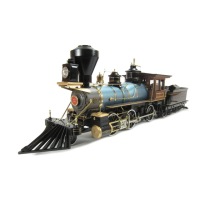Pull rods fitted
Valve Gear
It is not necessary to use all parts of the valve gear and parts can be used are at the discretion of the
modeler.
Make up the connecting rods (23) - again these are not handed but put the best side towards the
outside.
The model uses the existing crossheads, but an overlay is fitted to the outside. Remove the existing
connecting rod and clean up the outside face of the crosshead removing all detail, retain the thin
holding shim at the rear as this will be used when the crosshead is put back together. Fix the two part
crosshead arms (25) to the crosshead overlay (24) with 0.3mm wire. Glue the crosshead overlay to the
existing crosshead and re-assemble the connecting rod and crosshead using the 14BA nut and bolt and
retaining shim. Check the connecting rods work smoothly in the slide bars, it may be necessary to
slightly elongate the holes in the motion bracket for the slide bar to run parallel to the chassis. The gap
can be filled with a small wedge of plastic at a later stage.
Assemble the remainder of the valve gear (27-36), all joints are forked and retained with 0.45mm wire
except part (34) lifting arm, use a small piece of wire and file to a half round and fix between the raised
bosses, the link between the valve rod and the lifting arm is formed with the supplied brass pin at the
lower end and forked joint from the reversing rod lifting arm (35).
Points to note:
The simulated rolling bearing assembly (27-a-b-c) - the first part of the assembly is ‘a’, the second ‘b’
the hole in the centre should clear the rivet head and finally ‘c’ covers the rivet head.
The return crank (31-a-b-c) is screwed to the crankpin although some modelers may prefer to solder
the crank to the crankpin. Note etch ‘a’ the boss is face down towards the wheel, second is ‘b’ on top of
‘a’, ’c’ is on top of ‘b’ and is attached at the end to the valve rod only and when finally fitted a touch of
solder is used to retain in place on the main crank. If using a screwed return crank to increase the
amount of thread available a 14BA nut is soldered behind etch ‘a’ and reduced in thickness.
Packing pieces (37), small top, large lower, are supplied for the expansion links (30), there are two front
and two back overlays for each side. Before fitting to the fold down etch, place a rivet through the (large
hole, the rivet head should clear the hole reduce head if necessary) first overlay, the second or outer
overlay is then placed over the first (small hole) and fixed together then reduce the thickness of the rivet
head until it fits flush with the outer face of the fold down etch. It will be necessary to reduce slightly the
length of the rivet to squeeze the expansion link between the plastic expansion link brackets on the
motion bracket.
The reversing shaft brackets (36) there are several pieces for the centre of the bracket and the number
to be used can only be decided when assembling the bracket to align the various rods and links, also
provided are half etched end pieces to simulate the bolts holding the bracket. Again it may be
necessary to open up the hole in the motion bracket to fit the reversing shaft bracket.

